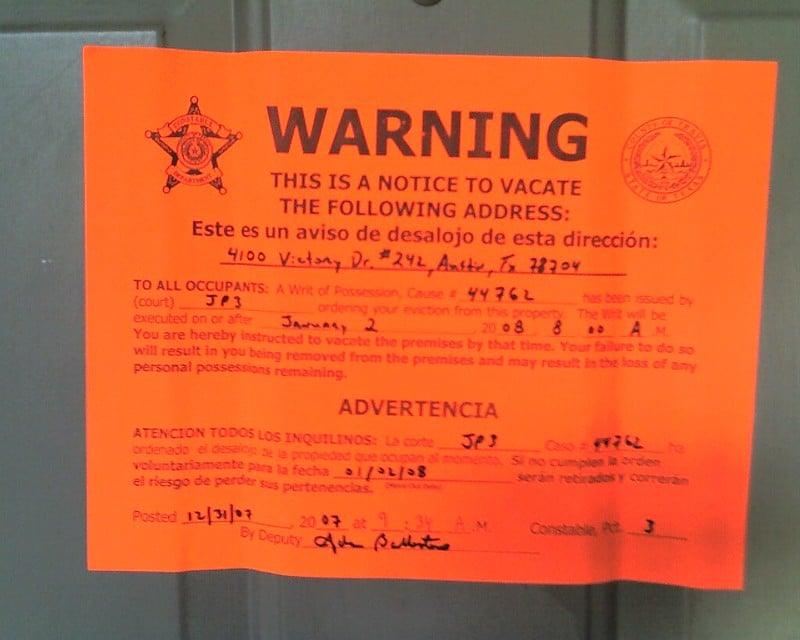 Q: Does the CDC’s Extension of the Eviction Moratorium Mean No One Is Being Evicted Now?
Q: Does the CDC’s Extension of the Eviction Moratorium Mean No One Is Being Evicted Now?
A: Unfortunately, no.
The CDC’s eviction moratorium has been extended until July 31. The Biden administration also announced an education campaign to help renters avoid eviction and said that the Consumer Finance Protection Bureau and Federal Trade Commission would take on enforcement. However, the order itself remains unchanged.
Extending the eviction moratorium while rental relief is being rolled out is extremely important. It will take a long time for those funds to be fully disbursed, and without a strong moratorium that aid won’t reach many households before the tenants’ housing court dates.
Nonetheless, even with the moratorium in place, there have been and will continue to be many, many Americans who lose their homes. In North Carolina, for example, only 3 percent of 71,000 eviction cases have been denied by judges while moratoriums were in place. The Private Equity Stakeholder Project has documented soaring numbers of evictions filed since the end of 2020 by corporate landlords. Why isn’t the moratorium preventing these and other evictions?
Here are 6 reasons:
- To be protected, the CDC moratorium requires that tenants make a legal declaration to their landlords indicating that they have lost income during the pandemic or have extraordinary out-of-pocket medical expenses and would be homeless if evicted. Landlords are not required to notify their tenants about this, so many tenants don’t know to exercise their rights to be covered by the moratorium.
- The moratorium only stops the actual physical removal from the home—many tenants are still experiencing the earlier steps of eviction, such as receiving notice, attending a hearing, or getting a judgment. Many tenants leave as soon as they get notice.
- Nonbinding guidance from the previous administration provided that landlords could file cases and even challenge the validity of a tenant’s declaration in court. As a result, judges have invalidated the declarations of some tenants who have had difficulty gathering proof of housing insecurity or income loss. Many others are afraid of possible legal consequences, like perjury penalties, for making the declaration in the first place. This guidance has yet to be rescinded.
- Only a fraction of governors and state supreme courts have issued orders interpreting and adopting the moratorium in the state. Only seven states require that landlords verify they have not received a declaration from the tenant prior to filing. In all other states, housing courts are under no obligation to ask landlords if they have received a declaration before allowing an eviction to proceed, let alone make landlords state under oath that they haven’t.
- Some judges agree with a landlord lawsuit that claims the moratorium is unconstitutional, and are allowing eviction cases that would be halted by the moratorium to proceed for plaintiffs while the landlord cases make their way through the courts.
- Some landlords are harassing tenants they cannot legally evict until the tenants feel they need to leave, or they are performing illegal “self-help” evictions (in other words, just locking tenants out of their homes).
- Though the CDC’s moratorium is not limited to nonpayment-of-rent cases, some other local moratoriums were, and some judges are allowing evictions for other reasons, such as the end of the lease term or manufactured minor lease violations or owner-move-in plans.
And, of course, even if all of these issues were addressed, any moratorium will be temporary and will not prevent evictions in the end without sufficient, equitable rental assistance or rent forgiveness.
To learn more about how the CDC moratorium should be improved, and the housing court system reformed going forward, check out our interview with Emily Benfer.
Correction: The article originally misstated what types of eviction cases the CDC’s moratorium covers—it is not limited to evictions for non-payment of rent.




Sorry, but Shelterforce Staff is guilty of speculation and making generalized observations not based on research.
1. Landlords ARE required by courts in many jurisdiction to notify tenants of CDC rights (true in Milwaukee County). “Many tenants don’t know their rights”? What is “many”?
2. “Many tenants leave as soon as they get notice”? Clearly not true because then you would not have *so many* evictions. Again, here in Milwaukee and many large jurisdictions the evictions keep getting adjourned while the moratorium is in effect.
3. This paragraph most clearly shows the bias and lack of understanding in your analysis. OF COURSE, landlords need the right to challenge a CDC Declaration. Take one of my cases from last October. My landlord client files eviction, T submits Declaration and makes initial contact with help agency. Then T never follows up, boyfriend continues to deal drugs, we challenge the Declaration, case is adjourned to January per CDC protection and then FINALLY, when we show judge email from agency that T has not responded to them the judge approves the challenge and issues eviction writ.
Another case: T submits Declaration in spite of being on full govt assistance and having NO income loss. T does this for simple purpose of delaying eviction. T wins two months free rent before L can get a court hearing on the Challenge. Likelihood that the FBI would bring a perjury charge against this person? Nil.
4. This paragraph completely ignores the fact that many large, urban jurisdictions have *local* rules, not statewide which require notice to tenants of their CDC rights.
5. Again, how does mentioning “some judges” ruling against the CDC give us any good idea how prevalent this is? It is only in a very few federal jurisdictions where the CDC Decl. has been ruled against and even in most of those there was NO injunction issued.
6. Harassment by landlords? How often? One case out of 50 where the rent hasn’t paid? One case out of 100? Those illegal self-help cases are actually rare and very expensive for the landlord if they are caught (I once got a $10k judgment against a L who evicted w/o using the sheriff).
Finally, dear Shelterforce Staff, I suggest that you talk to housing providers for a change if you want to present a balanced report. For example, you would learn about the tenant (family of four) who just got her $5600 federal stimulus check (as did most all tenants still enjoying the CDC protections) but won’t apply any of it to rent since she doesn’t have to worry about her eviction case until July 1.
“Finally, dear Shelterforce Staff, I suggest that you talk to housing providers for a change if you want to present a balanced report.”
Where did you get the idea that Shelterforce is interested in balanced reporting? Their MISSION is to “empower” tenants and poor people AGAINST landlords. Shelterforce is a liberal organization.
“For example, you would learn about the tenant (family of four) who just got her $5600 federal stimulus check (as did most all tenants still enjoying the CDC protections) but won’t apply any of it to rent since she doesn’t have to worry about her eviction case until July 1.”
This is typical liberal behavior.
rent forgiveness? Why are landlords obligated to support their tenants? Why not make grocery stores give out free food? what a bunch of nonsense!
This is how liberals roll! Always looking for a handout.